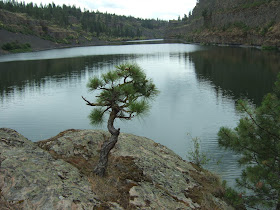1.5 billion year old schist on Bonnie Lake island. Shores of the lake are all much younger 14.5 million year old Columbia River Basalt
The Columbia River Basalts cover over most of the ancient rocks of the former edge of North America in Washington State. The ancient Precambrian rocks poke up above the basalt in a band of higher ground south of Spokane where the basalt flows are thin. There are outcrops in the deep Snake River canyon near the Idaho border where the Snake River has carved down through the basalts. And there are a couple of isolated summits such as Steptoe Butte that rise above the floods of basalt. These Precambrian rocks were part of the former western edge of the North American Continent before all that other stuff to the west got added on.
15 miles south of and 15 miles east of the higher ground not covered by the basalt are two isolated outcrops of Precambrian schist noted on the Rosalia 1:100,000 geology map (Waggoner, 1990). The two outcrops are within a canyon on the eastern edge of the great ice age flood routes on the east edge of the Cheney-Palouse Scabland Tract. One of the outcrops is an island in Bonnie Lake.
There are no roads to the lake shore and the lake is surrounded by private land, or where public, the cliffs present a challenge. However, Bjornstad and Kiver in On the Trail of the Ice Age Floods The Northern Reaches provide direction to access the island via watercraft up Rock Creek. The creek flows across private land but is a navigable waterway and hence is open to the public. Indeed fisherman use the creek to access the lake with small boats. This sounded like a great trip so after completing some field work elsewhere in eastern Washington, I camped at my secret hideout camp site in the Telford Scabland and then headed to Bonnie Lake in the morning (Aerial/Map View).
Scabland Tracts (Modified from USDA, 2007)
When glacial Lake Missoula drained in the great ice age floods the waters surged into the Spokane area rapidly filled glacial Lake Colombia or glacial Lake Spokane (depending on the Columbia ice margin) and spilled south across the Cheney-Palouse Scabland, the Telford Scabland and the Grande Coulee (not shown above).
As the water poured across the Cheney-Palouse Scabland Tract it encountered the Cheney Fracture Zone. The water scoured out the fractures which caused a significant of enough flow to be diverted eastward within the fractures to be concentrated at the Rock Creek flow path which carved a very deep canyon at Bonnie Lake. I suspect based on upstream topographic features that there may have been a precursor stream similar to Rock Creek today that may also have played a role in flow diversion. An even deeper canyon was carved downstream at Rock Lake as Rock Lake had added water diverted by another fracture zone as well as flows from flood waters that came down Pine Creek from the east. A similar but more spectacular capture of water into fractures or joints took place near Palouse Falls to the south (the-palouse-river-leaves-its-valley).
Rock Creek is crossed by Belsby Road which crosses the canyon between Rock Lake and Bonnie Lake. The creek is slow and passes through essentially a swamp of reeds and cat tails. I pumped up my inflatable kayak and began my paddle and enjoyed lots of birds. This included a female wood duck that played at having a broken wing and flopped around as though she could not fly to distract me as I glided past her ducklings hiding under the reeds.
In the swamp
Approaching the island
Landing spot
Upon landing I was greeted with schist containing a tightly folded quartz vein.
Tightly folded quartz vein
Muscovite-biotite-quartz quartzite schist
Island view looking north
Bjornstad and Kiver refer to the island as the Bonnie Lake Steptoe. A Steptoe is an isolated summit of older rock rising above younger rock. The name is derived from Steptoe Butte a summit 30 miles to the south of much older rock rising above the rolling Palouse landscape. In the case of the Bonnie Lake Steptoe, the island of 1.5 billion year old schist protrudes up into a lake carved 15,000 years ago with canyon cliffs composed entirely of 15 million year old basalt. A test of ones ability to grasp orders of magnitude.
Steptoe Butte is named for Colonel Steptoe who famously survived with most of his men an attack by a united group of Yakimas, Spokane and Columbia First Nations a few miles east of Bonnie Lake. The leader of that attack, Kamiakin, lived at Rock Lake to the south of here after the wars ended.
The island is public. It happens to fall within a section of State Trust Lands managed by the Washington State Department of Natural Resources. The one square mile section of land includes the island and both sides of the canyon. Perhaps not the most profitable Trust Land section; however, a timber harvest took place on the upland area on the western side of the canyon within the past two years and grazing leases are part of the revenue from these lands as well. The island has no special designation or protections, but was clean and appears to have been fairly well treated by the visiting fishermen.











Great information and so interesting. Thanks. Any idea which section that Trust land is? 16 or 32?
ReplyDeleteSection 36
ReplyDeleteMy bad. It just amazes me how the school sections can fall on the strangest places.. 2 and 32 where the four sections states UT, NM and AZ.
ReplyDeleteOne of your best posts ever. Thank you Dan.
ReplyDelete